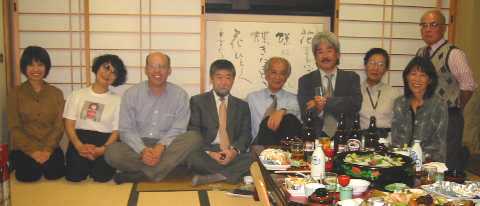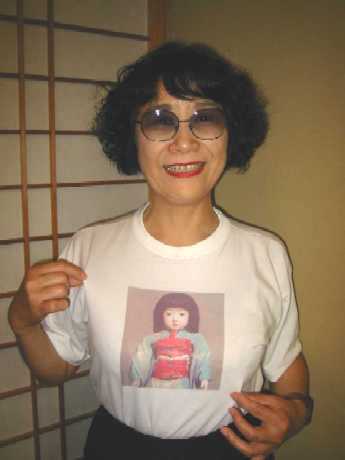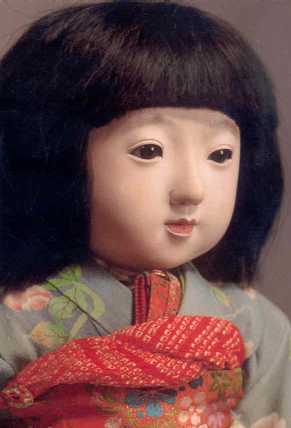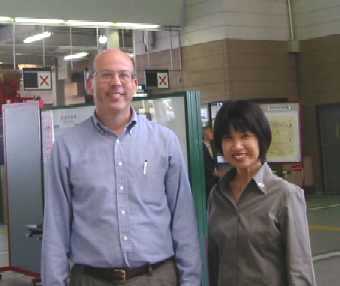|
|
|

|

|
With Miss Nagasaki Homecoming
Committee
at restaurant in Nagasaki City
|
|
|
This summer two members of the Miss Nagasaki
Homecoming Committee invited me to visit Nagasaki Prefecture's two remaining
Blue-eyed Dolls, one at Shimabara Daiichi
Elementary School and the other at Hirado
Kindergarten. Only two years ago it was discovered that the Japanese
Ambassador Doll at the Rochester Museum & Science Center is actually Miss
Nagasaki, even though for many years the doll was thought to be Miss Aomori.
Since the time of the discovery, many people in Nagasaki Prefecture have been
working actively to bring about a homecoming for Miss Nagasaki, one of the 58
Friendship Dolls sent from Japan in 1927 as a gift to the children of
America. The citizens of Nagasaki Prefecture are anxiously waiting for the
exhibition of Miss Nagasaki from February to April 2003 in the cities of
Nagasaki, Sasebo, Hirado, and Shimabara.
|
|
|

|
|
Shoko Yamashita models
Miss Nagasaki T-shirt
|

|
|
|
Many employees of the Nagasaki Shimbun, the leading newspaper in
Nagasaki Prefecture, are active members of the Miss Nagasaki Homecoming
Committee. The newspaper has provided the Committee with office space to work
on the homecoming activities. I contacted the Nagasaki Shimbun earlier
this year about translating a series
of articles about Miss Nagasaki and the Friendship Dolls. Mr. Hirobumi
Toyama, a retired high school English teacher, and Ms. Shoko Yamashita, a
reporter at the Nagasaki Shimbun, extended an invitation to me to visit
Nagasaki. They also kindly sent me a huge package of articles published by the Nagasaki
Shimbun and other materials about the Friendship Dolls in Nagasaki
Prefecture.
The beautiful coastal city of Shimabara was my
first stop in Nagasaki Prefecture. On Sunday evening there was a meeting about
the Friendship Dolls at a community center, and Mr. Toyama gave a long talk
about the history of Miss Nagasaki and the Friendship Dolls. I also talked
about some my activities related to the Friendship Dolls. This meeting was the
kickoff of activities in Shimabara to get ready for the exhibition of Miss
Nagasaki from April 3 to 8, 2003. Afterwards, I went
with about ten members of the Committee to eat some local delicacies at a
nearby restaurant. Some Committee members also accompanied me on my visit to
Shimabara Daiichi Elementary School on Monday morning, and a friendly couple showed
Mr. Toyama and me several sites of Shimabara after our visit to the school.
|
|
|
|
|

|

|
Miss Nagasaki
|
|
|
On Monday afternoon I traveled to the island of
Hirado to visit Hirado Kindergarten on Tuesday. On Tuesday evening there was a
party with the Homecoming Committee at a restaurant in Nagasaki City, so I
left Hirado in the early afternoon. However, I ended up on a train that stops
at every station, and I also got lost in the 3-block walk from Nagasaki
Station to my hotel, so I finally arrived at the party about an hour late
after everyone had started to eat. Even though I had never met Shoko
Yamashita, I recognized her because she appeared on a Friendship Doll video
that was shown to me when I visited Hirado Kindergarten. She came to the party
dressed in a T-shirt with Miss Nagasaki on front. The food at the party was
delicious, but I could not believe how much was brought out. I was not the
only person not able to finish the food brought for me, so many people made
use of "doggy bags" (a term everyone seemed familiar with even
though there is no specific word in Japanese for this).
The Miss Nagasaki Homecoming Committee gave me
several items related to the homecoming, including two sets of five postcards,
which consist of photos of Miss Nagasaki (2), the Blue-eyed Doll Ellen at
Hirado Kindergarten, the Blue-eyed Doll Little Mary at Shimabara Daiichi
Elementary School, and the Rochester Museum & Science Center where Miss
Nagasaki is kept. These special post cards are being sold at the post office
and other places in order to raise money to cover the expenses related to the
shipment of Miss Nagasaki from the U.S. and the exhibition of the doll in four
cities in Nagasaki Prefecture. They also gave me a couple of note pads with
Miss Nagasaki's photo on each page, a poster advertising Miss Nagasaki's
homecoming, and copies of 25 Friendship Doll articles published by the Nagasaki
Shimbun from July 4 to August 25, 2000.
Mr. Toyama has been my main contact with the
Miss Nagasaki Homecoming Committee since I sent my first letter to the Nagasaki
Shimbun in May of this year. He loves to write haiku, which is a Japanese
poem consisting of 17 syllables divided into 3 lines of 5, 7, and 5 syllables.
This spring, he visited Rochester, New York, where Miss Nagasaki is stored at
the Rochester Museum & Science Center. As part of his trip, he composed
some haiku in English. He says in order to write good haiku in Japanese you
need to know many words from nature, so he asked me what Americans call the
top part of an acorn. He said the dictionary indicated it is called a
"calyx" or "husk." I assured him that few English speakers
would appreciate the poetic beauty of the word "calyx," and most
Americans (including me) would have no idea what he is talking about. I
finally decided the best word may just be "acorn top." Mr. Toyama
has written many articles about the Friendship Dolls, and he edited a
children's book entitled Little Mary -- The Blue-eyed Doll--, which has
been used as supplemental material for Japanese high school students studying
English. Earlier this year he sent me a very interesting book entitled Stories
of Nagasaki, which he helped to edit. This book has about 50 vignettes
from the history of Nagasaki, including the story of the Friendship Dolls sent
to Japan in 1927.
|
|
|

|
|
|
Saying goodbye at Nagasaki Station
|

|
|
|
Many people in Nagasaki Prefecture extended
their kind hospitality to me during my stay, and I wish I could mention all of
them by name. One of the Homecoming Committee leaders in Shimabara gave me a
surprising gift, which was a booklet about the Friendship
Dolls at Matsuyama Elementary School in faraway Yamagata Prefecture. The
reason it was such a surprise was that Mr.
Yuji Suzuki, a leader of the Yamagata Blue-eyed Doll Association who I met
last year during my visit to Yamagata City Daiju Elementary School, had
earlier this year sent me a newspaper article about the dolls at the same
school. I had translated the article about the dolls to publish on my
Friendship Dolls web site. I also want to mention the special support extended
by many employees of the Nagasaki Shimbun, who I met in each of the
four cities where Miss Nagasaki will be displayed next year. The most
surprising meeting was in Sasebo, where I went from the train station to the
bus station in order to take a bus to Hirado. The Manager of the Sasebo Branch
of the Nagasaki Shimbun accompanied me between the stations, and we had
a very pleasant chat during the half hour or so I waited for the bus. Ms.
Yamashita and a volunteer worker from the newspaper really surprised me at the
Nagasaki train station on Wednesday morning when I was leaving Nagasaki to go to
Yamaguchi Prefecture. I went into a store to buy a box lunch to eat on the
train, and when I came out they were standing next to my luggage. I was a
little embarrassed that they recognized I was nearby by the huge size of my
suitcase on the sidewalk.
|
|
|